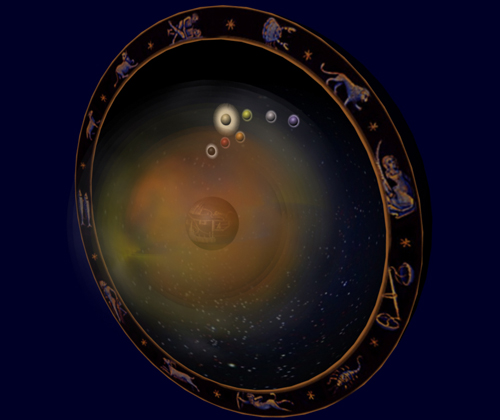Faculty: Nicoletta Adamo (Purdue University) and Paolo Fiamma (University of Pisa, Italy)
Students: Jesse Janowiak and Matt Barton
Sponsor: Museo Leonardiano, Vinci, Italy
 The project involved the design and development of an interactive, immersive installation for the Museo Leonardiano (Leonardo’s museum) in Vinci, Italy. The exhibit was part of a series of events aimed at celebrating Leonardo da Vinci’s Genius (‘Celebrazioni Leonardiane’, April 2008-July 2008) and its specific purpose was to let the viewers visualize and experience Leonardo’s visionary concept of an infinite, heliocentric universe (anticipatory of the Copernican System) as opposed to Ptolemy’s model of a finite, geocentric world. The viewers were first immersed in a 3D synthesized geocentric universe and taken through a virtual journey across the eight spheres of Ptolemy’s cosmological model. Then they travelled through Leonardo’s heliocentric world and explored it from unique points of view. In the first journey the visitors perceived the cosmos as a closed, static entity, whereas in the second voyage they experienced Leonardo’s revolutionary concept of an open, dynamic universe part of an infinite space. The interactive exhibit was based on the use of Virtual Reality (VR) and 3D Animation technologies. The hardware setup consisted of a single-screen portable immersive system with head and hand tracking technology and passive stereo. The visual content included 3D renderings of Ptolemy’s and Leonardo’s universes designed, modeled and animated by the authors in Autodesk Maya software. The audience reactions and comments demonstrated the effectiveness of the technology for visualizing the two systems and for conveying the contrast between the two cosmological models. The project described in the paper had two higher objectives. The first goal was to investigate the potential of VR technology as an educational/entertainment tool and as an instrument of historic research, simulation, reconstruction and dissemination in museums. The second objective was to initiate research toward the design of a novel museum space and technological infrastructure to support the development and display of VR immersive exhibits in the Da Vinci museum.
The project involved the design and development of an interactive, immersive installation for the Museo Leonardiano (Leonardo’s museum) in Vinci, Italy. The exhibit was part of a series of events aimed at celebrating Leonardo da Vinci’s Genius (‘Celebrazioni Leonardiane’, April 2008-July 2008) and its specific purpose was to let the viewers visualize and experience Leonardo’s visionary concept of an infinite, heliocentric universe (anticipatory of the Copernican System) as opposed to Ptolemy’s model of a finite, geocentric world. The viewers were first immersed in a 3D synthesized geocentric universe and taken through a virtual journey across the eight spheres of Ptolemy’s cosmological model. Then they travelled through Leonardo’s heliocentric world and explored it from unique points of view. In the first journey the visitors perceived the cosmos as a closed, static entity, whereas in the second voyage they experienced Leonardo’s revolutionary concept of an open, dynamic universe part of an infinite space. The interactive exhibit was based on the use of Virtual Reality (VR) and 3D Animation technologies. The hardware setup consisted of a single-screen portable immersive system with head and hand tracking technology and passive stereo. The visual content included 3D renderings of Ptolemy’s and Leonardo’s universes designed, modeled and animated by the authors in Autodesk Maya software. The audience reactions and comments demonstrated the effectiveness of the technology for visualizing the two systems and for conveying the contrast between the two cosmological models. The project described in the paper had two higher objectives. The first goal was to investigate the potential of VR technology as an educational/entertainment tool and as an instrument of historic research, simulation, reconstruction and dissemination in museums. The second objective was to initiate research toward the design of a novel museum space and technological infrastructure to support the development and display of VR immersive exhibits in the Da Vinci museum.
